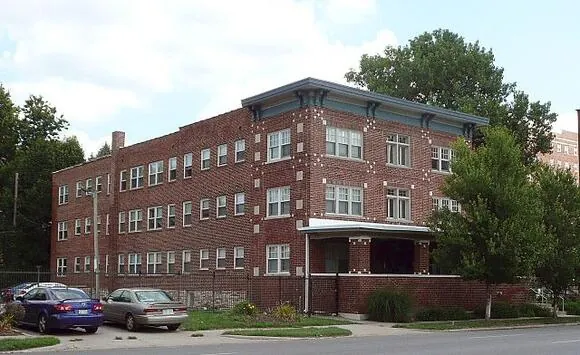Gillham House is the new name for the historic Gillham Court Apartment Building
In Kansas City, Missouri, the Gillham Court Apartment Building is located at 3411 Gillham Road. It was added to the National Register of Historic Places on November 7, 2007.
This building is described as a low-rise walk-up apartment structure. The foundation is made of limestone, and the walls are made of brick and concrete. Harry E. Fisher was the builder and developer.
This three-story skyscraper in midtown Kansas City located near Gillham Road and Armour Boulevard. Gillham Road is part of Kansas City’s historic Parks and Boulevard System. The construction of this long, rectangular structure was completed in 1925. It has a one-story porch that spans the whole width of the structure.
This apartment building is one of three created by Fisher, although it is only one of two that still stands. The structure is just approximately two feet back from the sidewalk, with empty lots on either side, one of which is paved. Nearby is the Armour Boulevard Multiple Resource Area Historic District II, which is also on the National Register.
The Gillham Court Apartments Building contains three apartment floors and a large basement. Inside, there is a corridor and a staircase, but no formal entrance lobby. Each story has the same floor layout, with four modest units on either side of the corridor. The basement is unfinished and serves as storage space.
The corridors feature original unit door openings, old wood floors, and plaster wall finishes. The flats include a four-room layout with a living and sleeping area, dining area, kitchen, and full bathroom. Some of the units had French doors in front of a large closet that might have housed a Murphy bed.
The structure is significant because it was constructed in the early 1900s, when the working and middle classes were rapidly rising. Because residential buildings were located along streetcar lines and during the building boom following World War I, apartment buildings were convenient if you worked in the city.
The Gillham Court Apartment project was Fisher’s sibling project on Locust Street, known as the Windsor Hall Apartments. The Gillham Plaza Apartments are no longer in operation. There was no elevator in the residential complexes.
The neighborhood was changing after World War I. big apartment buildings were being developed to replace big mansions built for the wealthy along Armour and Linwood Boulevards in the late 1800s. The running of streetcar lines encouraged commercial development as well as the construction of more residences for the working and middle classes.
East Armour and Linwood Boulevards had substantial apartment hotels and churches during the 1920s. There were approximately 30 low-rise walk-up apartment complexes at the end of the 1920s. More over a third of these no longer exist, yet they all supplied housing for approximately 700 people at the time.
Lower to middle-income residents occupied the Gillham Court Apartments and Fisher’s other two apartment projects. From the 1920s until the 1950s, renters included single women and men, widows, and married couples.
Some of the men worked as clerks or salespeople, while the ladies were frequently stenographers or nurses. The building manager was usually assigned long-term residency. As telephone usage increased, almost three-quarters of the tenants had phone service. Phone service had declined by the mid to late 1950s as vacancy rates increased.
The building is now known as Gillham House Apartments and is owned by Mac Properties.
Read More:
- EPA fines Kansas City marijuana company over $120,000 for violating a specific rule
- Authorities arrest Santa Barbara man accused of punching grandfather pushing baby in stroller in Calabasas







